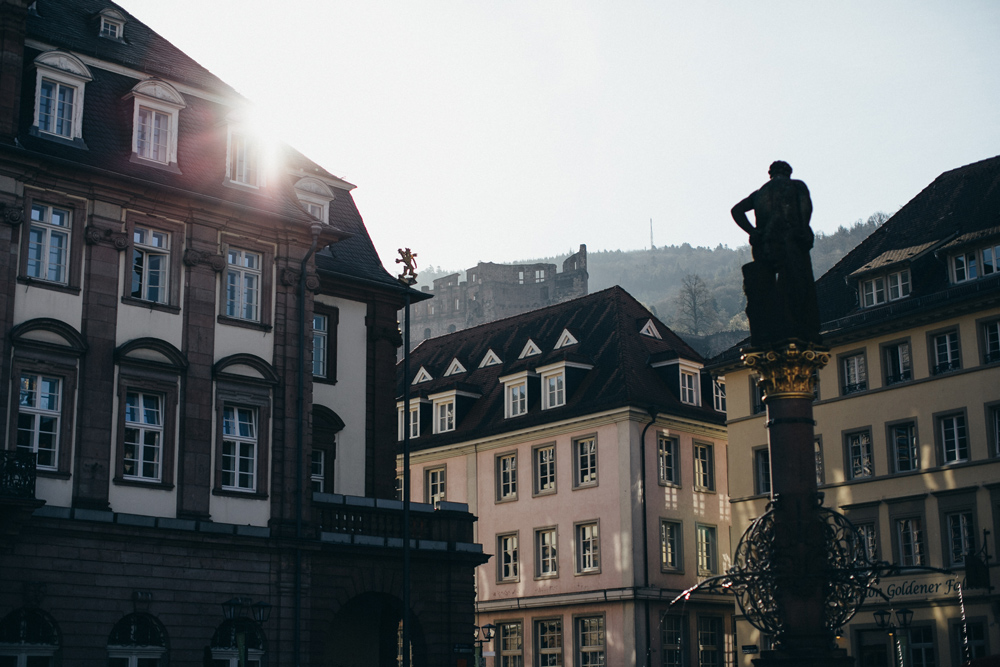“The tourists’ expectations have changed,” Birte says. Apart from standard tours, they mainly want our special motto tours: for example the tour about the exiled Frenchman Charles de Graimberg, who saved the castle at the beginning of the 19thcentury by supporting its preservation; or the ‘Being a Madame is a wretched trade’ tour about the life of Liselotte, Madame Palatine, sister-in-law of the French Sun King.
The Heidelberg Castle today: a wild and fascinating architectural mix.
Many visitors want to see the ‘Rittersprung’ (knight’s jump). This is a print in the sandstone of the Altan (the current terrace), possibly a footprint. Legend has it that a lady of the court amused herself with a nobleman. When the two were caught, the knight jumped out of the window and landed with such force that the shoe of his armour made an imprint in the castle floor. Another exciting story is that about the crack in the iron ring at the gate tower: A witch tried to bite through it in order to gain possession of the castle—fortunately unsuccessful.

Many visitors want to see the ‘Rittersprung’ (knight’s jump). This is a footprint in the sandstone of the Altan (the current terrace).
Experts in historical garbs tell the visitors these stories. The three ‘owners of the castle’ send visitors on tour through the ruin with the electoral night watch or with the ‘washerwoman’. This is fun, because what the gossip writer is today, was once the washerwoman. There are mottos such as ‘Welcome to the Stuarts’, starring the English princess at the Heidelberg court. “What began as an arranged marriage out of political motives, became a love story later,” Reglindis explains as we walk through the English part of the castle.

She is an art historian from the Taunus, who studied in Berlin and discovered early on that she enjoys conveying art. She established an agency for cultural management and started to design motto tours. Personal reasons made her come to Heidelberg, where an exhibition about Madame Palatine Liselotte took place in the 1980s. Reglindis designed special tours through Schwetzingen and Heidelberg—this is how she was led to the castle.

In the 13thcentury, the first residence of the Elector Palatine was established here. A medieval castle building was turned into a prestigious castle estate that is one of the most important cultural monuments in Germany today. It became a wild mixture of architectonic styles. Almost every Elector added a building in a new style. The Ruprechtsbau building was designed in Gothic style at the beginning of the 15thcentury. The Ottheinrichsbau building is a 16thcentury Renaissance masterpiece. At the beginning of the17th century, the Friedrichsbau was erected as a Late Renaissance building with a lush sculpture gallery of ancestral portraits. Shortly afterwards, the no-frills English building was constructed—much plainer. All these impressive buildings, however, were destroyed in the 17thcentury during the Thirty Years’ War and the Nine Years’ War. French combat units blew walls up various times. The castle fell into disrepair. When it was struck by lightning and finally burnt down in 1764, the Electors had long transferred their residence to the nearby town of Mannheim.

Every morning Birte walks up to her place of work from the old town below the castle and she always enjoys the impressive view of the place she has chosen for her own residence—Heidelberg. She is a North German from Husum and came to Heidelberg to study. She cannot imagine life in this town without the castle, “which dominates the townscape.” Andrea, the third team member was born in Darmstadt and ‘lost her heart in Heidelberg’, as the song goes. She may have dreamt of the life of a princess, the art historian admits with a smile. What Heidelberg is: a “romantic diva” in her eyes.

Their work requires lots empathy and the ability to improvise. The three directors have to keep creating new concepts for motto tours and the guides are as various as the tours they offer—among them are historians, teachers, physicians and senior citizens. Smooth operation and variety in the team are crucial, because the castle attracts some 1.2 million visitors per years, with some 50 guided tours on certain days during peak season just in Heidelberg.

The castle remains a special work place, even after 18 years. The women go into raptures about spring, where the hill turns green; about summer, where the clear blue sky is visible through the windows of the ruin; about autumn, where the splendid colours of leaves on the trees go well with the red sandstone; and about winter, where the court rests in fog, covered with a thin blanket of snow.

The three women are castle ladies, who love their jobs inside the ancient walls of Heidelberg Castle, where life creates new stories each day: exotic declarations of love, pale beloved ones, overly ambitious mothers-in-law, rose leaves, bizarre special requests and marriage proposals “with a success rate of 100 percent so far…”
www.schlosstouren.com























